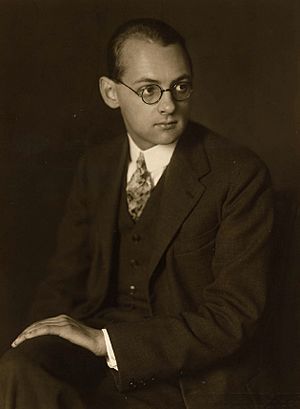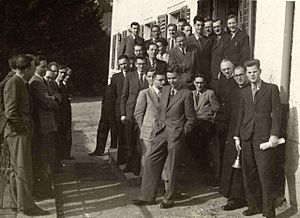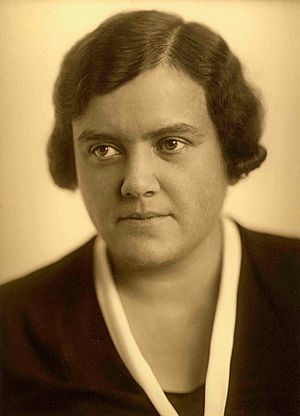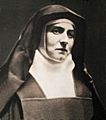Hans Urs von Balthasar facts for kids
Quick facts for kids
Hans Urs von Balthasar
|
|||||||
|---|---|---|---|---|---|---|---|
 |
|||||||
| Born | 12 August 1905 Lucerne, Switzerland
|
||||||
| Died | 26 June 1988 (aged 82) Basel, Switzerland
|
||||||
|
|||||||
| Scientific career | |||||||
| Influences | |||||||
| Influenced |
|
||||||
Hans Urs von Balthasar (born August 12, 1905 – died June 26, 1988) was an important Swiss Catholic priest and thinker of the 20th century. He wrote many books and articles about Christian faith.
He was chosen by Pope John Paul II to become a cardinal, which is a very high rank in the Catholic Church. However, he passed away just before this special ceremony. Cardinal Joseph Ratzinger, who later became Pope Benedict XVI, praised Balthasar's teachings, saying he "points the way to the sources of living water."
Along with Joseph Ratzinger and Henri de Lubac, Balthasar started a religious magazine called Communio. During his life, he wrote 85 books, over 500 articles, and translated almost 100 other works. He is especially known for his 15-volume series of books that explore beauty, goodness, and truth in faith.
Contents
Life and Career Highlights
Early Life and Family

Hans Urs von Balthasar was born in Lucerne, Switzerland, on August 12, 1905. His family was well-known. His father, Oscar, was an architect who designed churches. His mother, Gabrielle, helped start the Swiss League of Catholic Women. Hans Urs was the oldest of three children. His brother, Dieter, joined the Swiss Guard, and his sister, Renée, became a leader of a group of Franciscan nuns.
Hans Urs grew up in a very Catholic home. He remembered going to quiet morning Masses in the Franciscan church and beautiful Masses in the Jesuit church.
As a child, Hans spent a lot of time at a hotel his grandmother managed. This gave him a chance to experience different cultures and languages. He loved classical music, especially Schubert, Tchaikovsky, and Mahler. He spent many hours playing the piano.
His Education Journey
Hans Urs first studied with Benedictine monks at a school in Engelberg, Switzerland. Later, he moved to a more challenging school run by the Society of Jesus (Jesuits) in Feldkirch, Austria. Besides music, he was very interested in literature, with Dante and Goethe being important early influences.
He started studying German literature at the University of Zurich before he even finished high school. He also studied in Vienna and Berlin. In 1928, he earned his doctorate degree. His main paper was about how the idea of the "end times" appeared in German writings, using Catholic ideas. Even though it was a risky topic for a non-religious university, he earned the highest honors.
Joining the Jesuits
Even though he was a Catholic, Hans Urs wasn't very interested in theology until his university years. While studying in Vienna, he was influenced by his friend Rudolf Allers, who had converted to Catholicism. He also attended lectures by the theologian Romano Guardini in Berlin.
He felt a strong call to join the Society of Jesus, a Catholic religious order. He later wrote that Saint Ignatius of Loyola, who founded the Jesuits, "set me ablaze like a bolt of lightning." In November 1929, he joined the Jesuits in Germany.
After two years as a Jesuit beginner, he studied philosophy near Munich. He learned from Erich Przywara, who taught him about Scholasticism, a traditional way of thinking in theology. In 1932, Balthasar moved to Lyon, France, for four years of theology studies. There, he met other Jesuits like Henri de Lubac, who sparked his interest in the early Church Fathers (important Christian writers from ancient times).
Balthasar became a priest on July 26, 1936. His ordination motto was "He blessed it, broke it, and gave," referring to the words Jesus used at the Last Supper. After his studies, he worked for a religious magazine in Munich.
In 1940, he chose to become a student chaplain in Basel, Switzerland, instead of a university professor. He preferred working directly with people. In Basel, he edited a literary series, translated poetry, helped produce plays, and gave many lectures to students. He also started a group called the Studentische Schulungsgemeinschaft (Student Training Community) in 1941. This group offered courses and spiritual guidance to students, helping them grow in their faith. Many young men from this group later joined the Jesuits or found other ways to dedicate their lives to God.
Working with Adrienne von Speyr
Soon after arriving in Basel, Balthasar met Adrienne von Speyr, a doctor and a well-known person in Basel society. She was a Protestant who wanted to become Catholic. Balthasar began teaching her about the Catholic faith. He said she understood everything right away, as if she had been waiting to hear it.
After she became Catholic in November 1940, Speyr began having deep spiritual experiences, including visions of Christ's suffering. Balthasar became her spiritual guide to help her understand these experiences. He became convinced that her mystical experiences were real, and they both believed they had a shared mission in theology.
Between 1944 and 1960, Speyr spoke about 60 books of spiritual writings and Bible comments, which Balthasar wrote down. Since Speyr was a mother and a doctor, Balthasar took on the job of organizing, editing, and publishing her works. In 1947, he started a publishing house, Johannes Verlag, in Switzerland, to print her books.
Balthasar and Speyr also worked together to create the Johannesgemeinschaft (Community of Saint John) in 1945. This was a special group of Catholic laypeople (people who are not priests or nuns) who wanted to live a holy life in the world. Balthasar later left the Jesuit order to focus on this community, as his superiors felt it wasn't compatible with Jesuit life. He saw it as a very important personal mission. Speyr led the women's part of the community until she passed away.
Leaving the Jesuits
Starting in 1945, Balthasar faced some challenges. A Christmas radio sermon he was supposed to give was canceled because Jesuits were not allowed to work in Switzerland at the time. His father and godmother passed away, and a close Jesuit friend died of tuberculosis.
In 1946, his Jesuit leaders told him that the Society of Jesus could not be responsible for the Community of Saint John that he had started with Adrienne von Speyr. Feeling that God was calling him to this specific work, he decided to leave the Jesuit order in 1950, while remaining a priest. He saw this as a very serious step. He was offered a professorship at the University of Munich but turned it down. He did not have a formal role in the church until 1956, when he became a priest for the Diocese of Chur.
Writing and Publishing
After leaving the Jesuits, Balthasar had to support himself. He gave lectures across Germany and continued to lead retreats for young people. He also used this time to write many books and articles. These included works on Thérèse of Lisieux, prayer, and how Christians can live their faith in the modern world.
From 1956 until 1967, he lived in Basel with his friends Werner Kaegi and Adrienne von Speyr. During this time, even though he was diagnosed with leukemia, he wrote a huge seven-volume work called Herrlichkeit (The Glory of the Lord). This was the first part of a larger series about beauty, goodness, and truth in theology. He also continued to translate and edit works for his publishing house, especially those by Adrienne von Speyr.
Balthasar was not invited to the Second Vatican Council, a very important meeting of Catholic leaders that happened during this time. However, after his book Herrlichkeit was published, his reputation as a theologian grew a lot.
Adrienne von Speyr, who had been very ill, passed away on September 17, 1967. Balthasar then took on the full responsibility for the Community of Saint John.
Later Years and Honors
After moving to another house in Basel, Balthasar continued to write, edit, and translate a lot.
In 1969, Pope Paul VI appointed him to the International Theological Commission, a group that advises the Pope on religious matters. He also helped write a document on priestly spirituality for a meeting of bishops in 1971.
In 1971, with Joseph Ratzinger and Henri de Lubac, he started the international religious magazine Communio. This magazine aimed to offer a more traditional view of theology compared to other progressive journals. Balthasar said its mission was about Christian courage, to "expose oneself to risk." Karol Wojtyła (who later became Pope John Paul II) became the editor of the Polish version of the magazine.
In the 1970s, he received honors from the British Academy and other groups, as well as awards for his translations. In 1984, Pope John Paul II gave him the first Paul VI International Prize for his important contributions to theology. The next year, the Vatican held a special meeting about Adrienne von Speyr's work, which the Pope praised.
His Passing
Hans Urs von Balthasar's reputation grew so much that Pope John Paul II announced plans to make him a cardinal on May 29, 1988. However, Balthasar passed away in his home in Basel on June 26, 1988, just two days before the ceremony. He is buried in the cemetery of the Church of St. Leodegar im Hof in Lucerne.
At Balthasar's funeral, Cardinal Joseph Ratzinger (later Pope Benedict XVI) said that Balthasar was "right in what he teaches of the faith."
His Main Ideas
Hans Urs von Balthasar was a very broad thinker. He tried to respond to modern ways of thinking that challenged traditional Catholic ideas. He wanted Christianity to be more challenging to modern views, rather than just fitting in.
He was also known for his long study and discussions with Karl Barth, a famous Protestant theologian. Balthasar wrote the first Catholic analysis of Barth's work, and Barth himself called it the best book written about his own theology.
A unique idea in Balthasar's work is that our first experience after being born is seeing the loving face of our mothers. This is where we first meet another person ("Thou") in a relationship of love and care.
His Writings
The Trilogy
Balthasar is best known for his 16-volume series of books, published between 1961 and 1987. It's called a "trilogy" because it's divided into three main parts: Herrlichkeit (The Glory of the Lord), Theodramatik (Theo-Drama), and Theologik (Theo-Logic).
These three parts follow Jesus' description of himself in the Gospel of John 14:6: "I am the way, the truth, and the life." They also relate to the ideas of goodness, truth, and beauty. The trilogy starts with Herrlichkeit, which is about beauty.
Herrlichkeit (The Glory of the Lord)
This is a seven-volume work about theological aesthetics, which means studying God's beauty and how it appears in the world. One famous quote from this part is: "Within the beautiful—the whole person quivers. He not only 'finds' the beautiful moving; rather, he experiences himself as being moved and possessed by it."
The volumes are:
- Seeing the Form (1961)
- Studies in Theological Style: Clerical Styles (1962)
- Studies in Theological Style: Lay Styles (1962)
- The Realm of Metaphysics in Antiquity (1965)
- The Realm of Metaphysics in the Modern Age (1965)
- Theology: The Old Covenant (1967)
- Theology: The New Covenant (1967)
Theodramatik (Theo-Drama)
This is a five-volume work that looks at the actions of God and how humans respond, especially during the events of Good Friday, Holy Saturday, and Easter Sunday. It explores ideas about ethics, salvation, and the nature of Christ.
The volumes are:
- Prolegomena (1973)
- Dramatis Personae: Man in God (1976)
- Dramatis Personae: Persons in Christ (1978)
- The Action (1981)
- The Last Act (1983)
Theologik (Theo-Logic)
This is a three-volume work about theological logical theory. It describes the truth about how Jesus Christ's nature relates to reality itself. The first volume, Truth of the World, was originally published in 1947 and later revised to be part of this series.
The volumes are:
- Truth of the World (1985)
- Truth of God (1985)
- The Spirit of Truth (1987)
Other Important Works
Balthasar also wrote about the lives of saints and early Church Fathers. He believed that saints showed how to live a Christian life. He saw his theology as a "kneeling theology," connected to prayer, and a "sitting theology," connected to faith guided by the heart and mind of the Catholic Church.
He wanted his writings to help with spiritual and practical issues. He always said that his theology was deeply connected to the mystical experiences of his friend, Adrienne von Speyr.
Debate on Hope and Salvation
In his 1987 book, Dare We Hope "That All Men Be Saved"?, Balthasar discussed the idea of whether everyone will go to heaven. Some critics thought he was saying that everyone *will* be saved, a belief called universalism. However, many others disagree, saying this is a misunderstanding of his work.
Balthasar himself said that people can definitely be lost (go to hell). But he also said that Christians should charitably hope that everyone will be saved. He asked, "How can anyone equate hoping with knowing? I hope that my friend will recover from his serious illness—do I therefore know this?" He believed that while faith might reject the idea that everyone *will* be saved, hope encourages us to pray and wish for it.
He also explored the "Theology of Holy Saturday" and "Christ's descent into Hell" in his book Theo-Drama. This refers to the time Jesus spent in the tomb and his journey to the dead before his resurrection. This topic is still debated by theologians.
Works List
Here are some of Hans Urs von Balthasar's other works:
- The Christian and Anxiety (1951)
- Christian Meditation (1984)
- The Christian State of Life (1977)
- Convergences (1969)
- Cosmic Liturgy: The Universe According to Maximus the Confessor (1941)
- Credo (1988)
- Dare We Hope "That All Men Be Saved"? with a Short Discourse on Hell (1986/1987)
- Does Jesus Know Us? Do We Know Him? (1980)
- Elucidations (1971)
- Engagement with God (1971)
- Epilogue (1987)
- Explorations in Theology, Vol. 1: The Word Made Flesh (1960)
- Explorations in Theology, Vol. 2: Spouse of the Word (1961)
- Explorations in Theology, Vol. 3: Creator Spirit (1967)
- Explorations in Theology, Vol. 4: Spirit and Institution (1974)
- Explorations in Theology, Vol. 5: Man Is Created (1986)
- A First Glance at Adrienne von Speyr (1968)
- The Grain of Wheat: Aphorisms (1944)
- Heart of the World (1944)
- In the Fullness of the Faith: On the Distinctively Catholic (1975)
- The Laity in the Life of the Counsels (1993)
- Life Out of Death: Meditations on the Paschal Mystery (1984)
- Light of the Word (1987)
- Love Alone is Credible (1963)
- Mary for Today (1987)
- The Moment of Christian Witness (1966)
- My Work in Retrospect (1990)
- Mysterium Paschale: The Mystery of Easter (1969, second edition in 1983)
- The Office of Peter and the Structure of the Church (1974)
- Our Task (1984)
- Paul Struggles with His Congregation (1988)
- Prayer (1955)
- Priestly Spirituality (2007)
- Razing the Bastions (1952)
- Romano Guardini: Reform from the Source (1970)
- A Short Primer for the Unsettled Layman (1980)
- The Theology of Henri de Lubac: An Overview (1976)
- A Theology of History (1959)
- The Theology of Karl Barth (1951)
- The Threefold Garland (1977)
- To the Heart of the Mystery of Redemption (1980)
- Truth is Symphonic: Aspects of Christian Pluralism (1972)
- Two Sisters in the Spirit (1970)
- Unless You Become Like This Child (1988)
- Who is a Christian? (1965)
Images for kids
-
Saint Teresia Benedicta of the Cross (Edith Stein)
See also
 In Spanish: Hans Urs von Balthasar para niños
In Spanish: Hans Urs von Balthasar para niños
- Eternal super-kenosis








